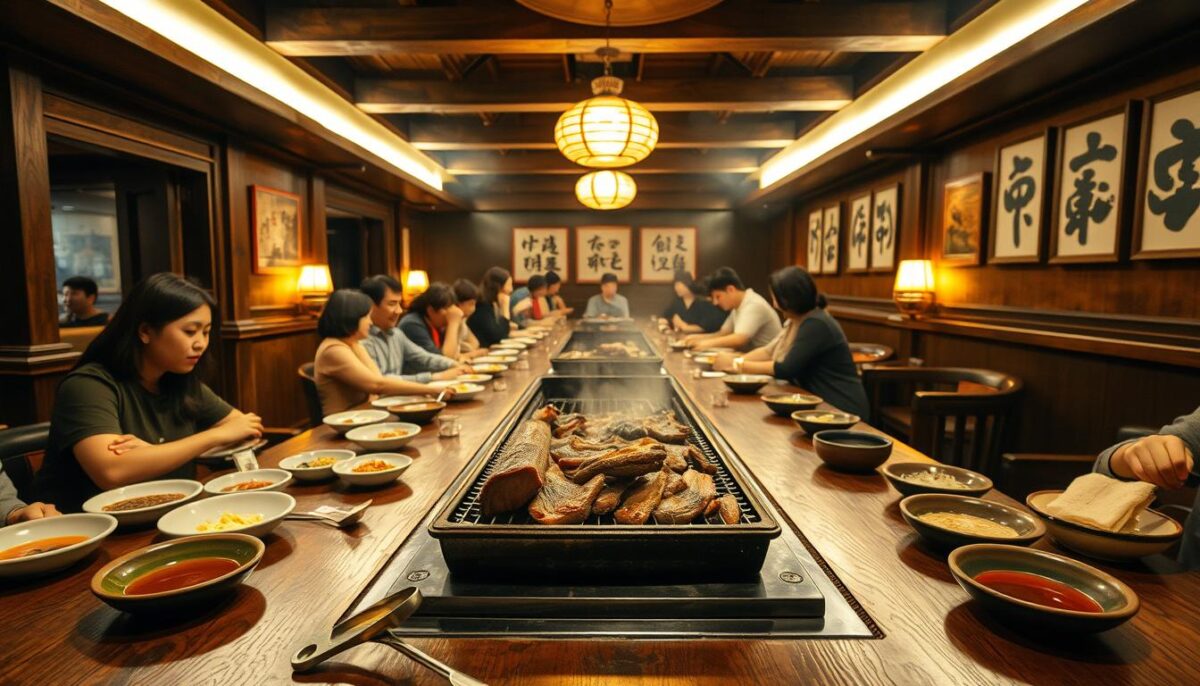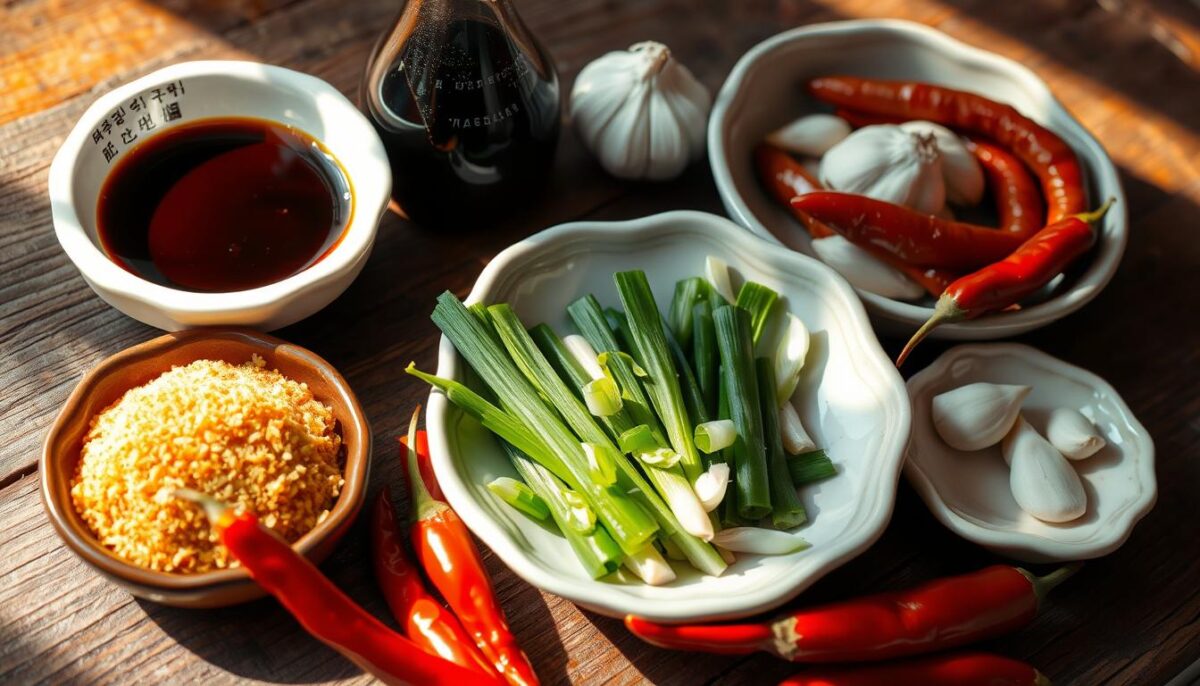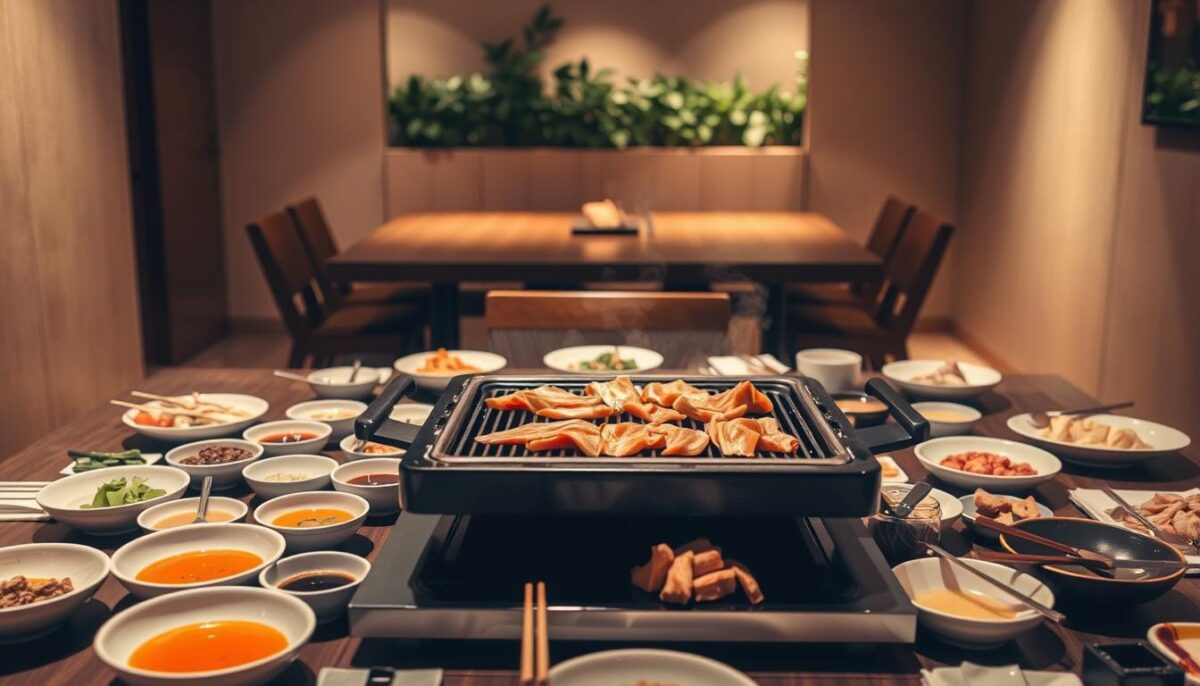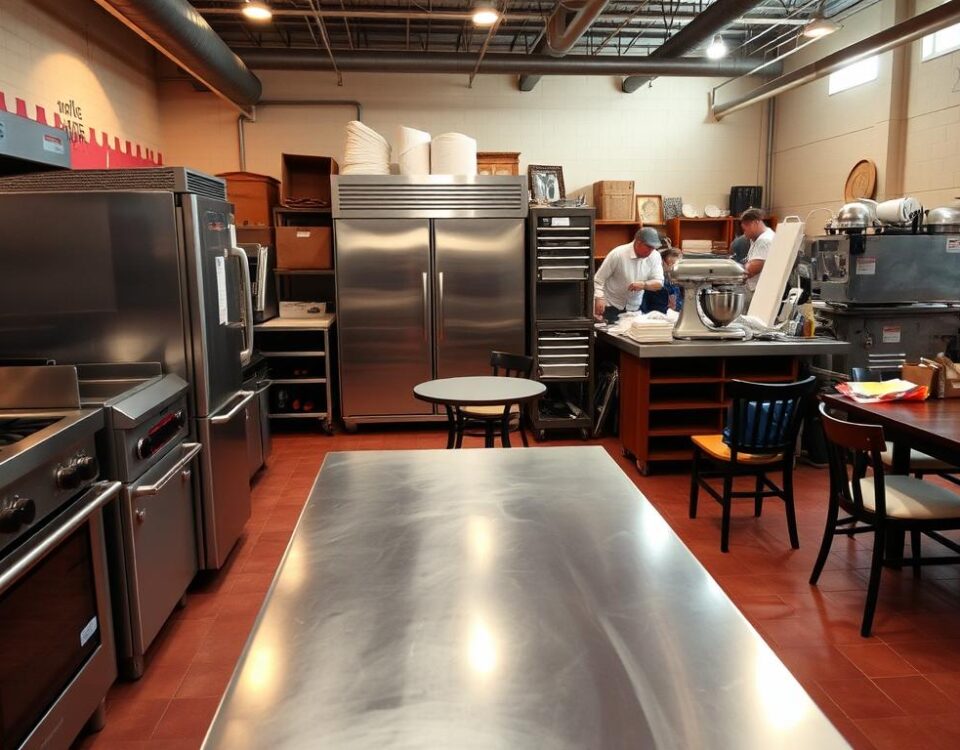
The Soul of Spain: Tapas Recipes That Bring the Fiesta to You
April 27, 2025
Thai Kitchen Essentials: 7 Dishes That Define Thailand
April 28, 2025There’s something magical about gathering around a sizzling grill with friends, laughter bouncing off the walls as everyone leans in to flip their favorite cuts. For years, I worked in restaurants where this energy thrived—but nothing compares to bringing that warmth into my own kitchen. Hosting these evenings has become more than a meal; it’s a celebration of connection, flavor, and shared joy.
I’ll never forget the first time I tried hosting. My tiny apartment filled with smoke, but the smiles and stories made it unforgettable. Now, after two decades of perfecting the art, I’ve learned that the secret lies in simplicity: a hot grill, quality ingredients, and the right balance of salty, sweet, and savory. The best part? Everyone becomes a chef at their own pace, creating bites tailored to their cravings.
Whether it’s thinly sliced brisket caramelizing on the grates or crisp lettuce wraps piled high with garlicky sides, every detail matters. Let’s dive into how you can craft this experience—no restaurant reservation required.
Key Takeaways
- Transform your space into a lively, interactive dining experience with minimal effort.
- Prioritize quality cuts of meat and fresh side dishes for authentic flavor.
- Use a portable grill to encourage guest participation and conversation.
- Balance bold marinades with light, refreshing accompaniments like kimchi.
- Embrace the mess—it’s proof of a memorable, shared cooking adventure.
Setting the Scene for a Korean BBQ Night at Home
My dining room transformed the first time I placed a sizzling hot plate at its heart. I learned early that location shapes energy—now I always position the cooking station near open windows or under patio string lights. The space becomes alive with chatter as guests lean in to sear their chosen bites.
Creating a Welcoming Atmosphere
Comfort is key. I use floor cushions around low tables for casual intimacy, paired with warm Edison bulbs overhead. A simple trick? Place banchan in colorful small bowls within everyone’s reach. The clink of metal tongs against the grill mixes with laughter—a symphony of shared creation.
Lessons From My First Smoke-Filled Evening
Twenty years ago, I overcrowded a folding table with mismatched plates. Today, I follow this layout:
| Element | Indoor Setup | Outdoor Setup |
|---|---|---|
| Grill Position | Central, near ventilation | Protected from wind |
| Dish Arrangement | Lazy Susan for sides | Weatherproof serving trays |
| Seating | Floor cushions | Bench seating |
My favorite memory? A rainy evening where steam rose alongside stories as we grilled bulgoki indoors. The experience taught me that perfection lies in adaptability—not flawless execution.
Understanding the Tradition of Korean BBQ
The aroma of seared meats and fermented spices tells a story centuries old, one I’ve come to cherish in my own kitchen. This culinary practice isn’t just about cooking—it’s a tapestry of history woven through shared meals. Let’s explore how ancient customs shape today’s gatherings.

Historical Roots and Cultural Significance
Grilling meats over open flames dates back to Korea’s Goguryeo era (37 BCE–668 CE). Back then, warriors marinated thinly sliced beef in soy and sesame—early versions of bulgogi. By the Joseon dynasty, royal kitchens elevated these methods, pairing meats with fermented side dishes to balance richness.
Communal dining became central to social bonds. Families gathered around charcoal braziers, turning meals into collaborative rituals. Today, this tradition thrives—not in palaces, but in homes where everyone contributes to the feast.
The Role of Banchan and Communal Dining
No korean barbecue is complete without banchan. These small plates—think spicy kimchi or tangy pickled radish—add texture and contrast. I always include at least six varieties on my table. Here’s why they matter:
| Banchan Type | Flavor Profile | Pairing Purpose |
|---|---|---|
| Kimchi | Spicy, fermented | Cuts through fatty meats |
| Pickled Radish | Sweet, crisp | Refreshes the palate |
| Spinach Namul | Savory, sesame | Adds earthy balance |
When hosting, I arrange these side dishes in vibrant bowls within easy reach. It sparks conversation as guests mix flavors, creating their perfect bite. This interplay—of history, community, and taste—is what makes every meal unforgettable.
Planning My Ultimate Korean BBQ Experience
The key to a seamless grilling experience lies in meticulous preparation. Years of hosting taught me that success begins long before the first bite sizzles. Let’s break down how to balance logistics with creativity.
Guest Count, Food Quantities, and Timing
Start by confirming your guest list. For six people, I buy 4-5 pounds of meats—including crowd-pleasers like pork belly and ribeye. A good rule? Plan ½ to ¾ pound per person. Double that if your friends are big eaters!
Marinating takes time. I prep pork belly in soy-garlic glaze 24 hours ahead, while simpler cuts like brisket get seasoned just before cooking. Side dishes? Make kimchi fried rice the day before—it frees up stove space later.
Gathering Inspiration from Local Markets
Walking through local Korean grocery aisles sparks ideas. At H-Mart, I discovered perilla leaves for wraps and pre-marinated kalbi short ribs. Their banchan section inspired me to add pickled lotus root to my spread—a tangy crunch guests now request every time.
Pro tip: Chat with butchers about thickness preferences. Thin slices cook faster, perfect for groups eager to eat while chatting. Balance rich meats with light sides like cucumber salad—your guests (and ventilation system) will thank you.
Choosing the Perfect Grill and Stove for Korean BBQ
A reliable setup isn’t just about heat—it’s the foundation of every delicious bite. After testing countless models, I’ve found that equipment choice makes or breaks the experience. Let’s explore how to balance functionality with practicality.

Indoor vs. Outdoor Cooking Considerations
Location matters. Outdoor setups offer natural ventilation but require wind protection. Indoors? Prioritize proximity to windows or exhaust fans. My go-to solution? A portable butane stove—it’s compact, adjustable, and minimizes smoke buildup.
| Factor | Indoor | Outdoor |
|---|---|---|
| Heat Source | Butane stove | Charcoal grill |
| Ventilation | Required | Natural airflow |
| Space Needs | Compact | Spacious |
Equipment Essentials for a Great BBQ
Three items are non-negotiable:
- A cast-iron grill plate with ridges—distributes heat evenly
- Butane stove with adjustable flame
- Drip tray to catch excess oil
Why butane? It offers precise temperature control—crucial for caramelizing marinades without burning. Pair it with a thick grill plate to prevent hotspots when you grill meat. Clean surfaces after each use with a stiff brush; residue causes flare-ups.
Pro tip: Line the drip tray with foil for easy cleanup. A little oil brushed on the grill prevents sticking, letting you focus on the sizzle rather than the scramble.
Preparing Authentic Korean BBQ Meats and Marinades
The sizzle of thinly sliced beef hitting a hot grill still makes my mouth water—even after twenty years of perfecting marinades. My secret? Treat each cut like a canvas. Whether it’s bulgogi or pork belly, the magic happens when sweet, salty, and umami collide.

Marinating Mastery: Layers of Flavor
For tender bulgogi, I slice ribeye paper-thin against the grain. The marinade? A punchy mix of soy sauce, grated pear (natural tenderizer), brown sugar, and sesame oil. Let it soak overnight—the meat absorbs flavors like a sponge. Pro tip: Add grated onion for extra juiciness.
Pork belly needs simpler treatment. A quick rub of gochujang paste, garlic, and honey creates sticky caramelization in minutes. Always pat meats dry before grilling—moisture is the enemy of that perfect sear.
Heat Control for Melt-in-Your-Mouth Results
High heat is crucial. I cook bulgogi in small batches to avoid steaming. Let edges char slightly—that’s where the umami explosion lives. For pork belly, medium heat renders fat slowly, creating crispy yet tender bites.
Never underestimate dipping sauces. My go-to trio: ssamjang (spicy bean paste), sesame salt, and vinegar-soy mix. They cut through richness and let guests customize each bite. Pair with perilla leaves or lettuce wraps for crunch.
Korean BBQ night at home: The Ultimate Guide to Setting Up Your Table
A well-organized table transforms chaotic cooking into shared joy. I learned this after hosting dozens of gatherings where strategic placement made all the difference. Your setup should invite collaboration—think of it as a culinary stage where everyone plays a role.

Arranging Your Grill and Serving Areas
Center the grill on a heat-resistant mat, leaving 18 inches of clear space around it. I use a lazy Susan for sauces and sides—it keeps items accessible without overcrowding. Place lettuce leaves and salad bowls at opposite ends to encourage movement and mingling.
Pro tip: Position tongs and scissors near the grill’s edge. Guests instinctively reach for them when flipping meats, creating a natural flow. For larger groups, add a second plate station with extra napkins—it prevents traffic jams during peak grilling moments.
Essential Tableware and Utensils
These items never leave my setup:
- Long-handled metal tongs (prevents splatter burns)
- Stainless steel scissors for snipping meats
- Small plates for individual servings
- Dual-compartment bowls for sauces
Keep lettuce crisp by layering leaves on ice-filled trays. Salad components like shredded carrots or bean sprouts thrive in shallow dishes with spoons—guests can build wraps without double-dipping. Remember: A clutter-free surface lets the grill meat like a pro moments shine brighter than any decoration.
Crafting Delicious Dipping Sauces and Side Dishes (Banchan)
The right sauce can turn a good bite into an unforgettable one. Over the years, I’ve discovered that bold flavors thrive when paired with thoughtful side dishes. Let’s explore how to build a symphony of tastes that dance between spicy, tangy, and nutty.
Signature Dipping Sauce Recipes
My go-to trio always includes ssamjang—a mix of fermented bean paste, gochugaru, and sesame oil. For a crowd-pleasing twist, I blend these ingredients:
| Sauce | Ingredients | Flavor Notes |
|---|---|---|
| Ssamjang | Doenjang, gochujang, garlic, honey | Savory with subtle heat |
| Citrus-Soy | Soy sauce, lime zest, sesame seeds | Bright and tangy |
| Spiced Mayo | Mayo, gochugaru, rice vinegar | Creamy with a kick |
Adjust spice levels by reducing gochugaru or adding a spoonful of sugar. Prep these sauces 2 hours ahead—flavors deepen as they rest.
Must-Try Banchan Options to Complement the Meal
Side dishes should contrast textures and cleanse the palate. My essentials include:
| Banchan | Prep Time | Role |
|---|---|---|
| Quick Kimchi | 10 mins | Adds fermented crunch |
| Sesame Spinach | 5 mins | Offers earthy balance |
| Sweet Squid Salad | 15 mins | Introduces chewy texture |
A drizzle of sesame oil over blanched veggies elevates their aroma. Store banchan in airtight containers—they stay fresh for days and simplify future meals.
Mastering the Art of Wraps: Ssam and Rice Paper Techniques
There’s a satisfying rhythm to building the perfect handheld bite—layering textures and flavors until every component sings. I’ve found that wraps transform meals into interactive experiences, letting guests craft their ideal flavor combinations. The secret? Balance over bulk.
Traditional Lettuce and Perilla Wraps
Start with crisp lettuce leaves—butter or romaine work best. Place a piece of grilled meat in the center, then add a smear of gochujang paste for heat. Top with pickled radish and a sesame leaf for aromatic contrast. Fold like a taco, ensuring ingredients stay snug without tearing the lettuce.
Innovative Rice Paper Wrap Methods
For a lighter twist, soak rice paper briefly in warm water. Layer shredded carrots, fresh herbs, and thinly sliced beef. Drizzle with ssamjang paste mixed with lime juice. Roll tightly, tucking sides inward—think burrito technique. The chewy texture pairs beautifully with crispy banchan.
My golden rule? Less is more. Overstuffing leads to messy bites. Stick to 2-3 main components per wrap, using sauces as glue rather than fillers. Offer both options on your table—some prefer the peppery punch of perilla, while others enjoy rice paper’s neutral base.
| Component | Traditional | Rice Paper |
|---|---|---|
| Base | Lettuce/perilla | Hydrated sheets |
| Sauce | Gochujang focus | Ssamjang blend |
| Texture | Crisp | Chewy |
Prep leaves and rice papers ahead, storing them under damp towels to prevent drying. When guests see the spread of options, they’ll eagerly experiment—proof that great meals thrive on creativity.
Grilling Vegetables and Other Non-Meat Options
Grilled vegetables transformed my table from meat-heavy spreads to vibrant feasts. I discovered their power during a dinner where a guest preferred plant-based options—the charred eggplant and mushrooms became stars. Now, I treat them with the same care as premium cuts, balancing smoky depth with fresh crunch.
Choosing Fresh Vegetables for Grilling
Select firm, seasonal produce. Look for onions with tight skins and mushrooms with closed gills. Kabocha squash should feel heavy for its size—a sign of dense, sweet flesh. Avoid wilted greens or bruised veggies; they lose texture when heated.
Slice onions into thick wedges to prevent burning. Toss salad greens like romaine in oil just before grilling—they crisp quickly. For zucchini, angle-cut slices at ¼ inch. This maximizes surface area for caramelization while keeping centers tender.
Use high heat for quick-charring asparagus or bell peppers. Medium heat works better for squash or mushrooms, allowing natural sugars to develop. Brush with a mix of sesame oil, soy sauce, and minced garlic during the last minute. It adds glossy flavor without overpowering.
Arrange grilled veggies on a platter with fresh herbs. The bright colors and varied textures create visual appeal. Serve alongside light salads dressed in rice vinegar—it cuts through rich flavors and refreshes the palate.
Beverage Pairings to Elevate Your Korean BBQ Night
The clink of glasses filled with frosty drinks signals the start of something special—a meal where every sip enhances the bite that follows. Over the years, I’ve learned that thoughtful pairings turn a good spread into an unforgettable party. Let’s explore how to match flavors without overshadowing the star of the show: the food.
Soju, Beer, and Other Drink Selections
Soju’s clean, slightly sweet profile cuts through rich meats like pork belly. I serve it chilled in small shot glasses—it encourages sipping between bites. Light lagers work similarly, their crisp bubbles scrubbing the palate clean. My go-to? A citrus-forward ale that dances with spicy gochujang marinades.
Non-alcoholic options matter just as much. Sparkling water with lime wedges refreshes guests between courses. For something bolder, try iced barley tea—its nutty undertones complement smoky flavors beautifully.
| Drink Type | Flavor Profile | Pairing Purpose |
|---|---|---|
| Soju | Clean, subtly sweet | Balances fatty meats |
| Light Beer | Crisp, effervescent | Cleanses spicy bites |
| Iced Barley Tea | Toasty, earthy | Enhances grilled veggies |
| Sparkling Water | Neutral, bubbly | Resets the palate |
Always offer variety. At my last gathering, someone brought passionfruit soda—its tropical sweetness became a surprise hit. Remember: a well-rounded course includes options for every preference. Keep pitchers of water nearby too; hydration keeps the conversation flowing as smoothly as the drinks.
Tips for Managing Smoke and Ensuring Optimal Ventilation
The first time I grilled indoors, my living room looked like a foggy morning scene—but with sesame oil notes. Now, I’ve mastered strategies to keep air clear while preserving those flavors we crave. Proper ventilation isn’t just practical—it’s the unsung hero of every successful indoor feast.
Indoor Ventilation Strategies
Position your grill near open windows or sliding doors. I angle a box fan outward to pull smoke away from seating areas. This simple setup creates airflow that whisks particles outside instead of into curtains.
Central ceiling fans work wonders too. Set them to low speed, rotating counterclockwise to push rising smoke toward vents. Combine this with cracked windows across the room—it creates a cross-breeze way more effective than single-point solutions.
Take breaks every 20 minutes to let smoke dissipate. I use these pauses to refresh drinks or serve banchan. It’s a smart way to maintain air quality without interrupting the meal’s rhythm.
Always make sure your grill’s drip tray is empty. Overflowing fats produce thicker smoke. Wipe surfaces with a damp cloth mid-cook—this prevents burnt residue from amplifying haze.
Pro tip: Boil citrus peels in water nearby. The steam neutralizes lingering odors while adding a fresh citrus note to the flavors in the air. Just make sure to keep the pot away from direct heat!
Where to Buy the Best Korean BBQ Essentials
Finding premium ingredients transformed my grill nights from smoky experiments to authentic feasts. Whether you’re hunting for tender meats or niche spices, knowing where to shop makes all the difference. Let’s break down the best spots to stock your pantry.
Local Markets and Grocery Stores
Nothing beats the vibrant aisles of local Korean markets. At H-Mart or Zion Market, you’ll find pre-marinated pork belly, fresh banchan, and handmade ssamjang. Butchers here slice meats paper-thin—perfect for quick grilling. Grab perilla leaves from produce sections and ask staff for “gireumjang” (seasoned sesame oil) recommendations.
These stores often stock rare items like fermented soybean paste or gochugaru flakes. Pro tip: Visit early for the best pork cuts and check weekly sales for bulk deals on kimchi.
Online Shopping and Specialty Stores
Can’t find bamboo salt or rice paper locally? Online retailers like Airirang deliver authentic staples nationwide. I order coarse salt blends and pre-cut short ribs here—they arrive chilled in insulated boxes. Specialty sites also offer niche tools like grill scissors or stone dipping bowls.
For time-crunched hosts, meal kits provide pre-portioned options. Just ensure sellers use quality pork and avoid artificial preservatives. Always read reviews to confirm freshness.
| Option | Best For | Price Range |
|---|---|---|
| Local Markets | Fresh meats, banchan | $–$$ |
| Online Stores | Rare spices, specialty tools | $$–$$$ |
Mix local Korean hauls with online finds for a balanced approach. Grab gochujang in-store but splurge on imported salt varieties digitally. Exploring both options ensures every bite tastes like it came straight from Seoul.
Conclusion
Hosting these gatherings taught me that magic lives in shared moments—the sizzle of marinated bulgogi, laughter echoing as guests build lettuce wraps. With quality pork cuts, coarse salt for seasoning, and patience, anyone can craft this experience.
Remember: Thinly sliced meats caramelize best. A dash of grated onion in marinades adds juiciness. Keep your grill hot and banchan fresh. My most cherished memories? Friends debating whose bulgogi flip technique reigns supreme.
Don’t fear experimentation. Swap sauces, try new onion varieties in ssamjang, or grill pork belly with honey-glazed pears. The beauty lies in making it yours.
Now light that grill. Let smoky aromas mingle with conversation. Every bite celebrates tradition—and the joy of creating something unforgettable together.
FAQ
What’s the best way to manage smoke indoors while grilling?
I always open windows and use a portable fan near the grill. A tabletop grill with a built-in ventilation system or a splatter screen also helps reduce smoke.
How do I choose between indoor and outdoor cooking setups?
It depends on space and convenience. I prefer indoor electric grills for smaller gatherings, but outdoor charcoal grills add smoky flavor for larger groups.
What are the must-have banchan for a balanced meal?
My go-tos are kimchi, seasoned spinach, and pickled radish. They add texture and bright flavors that cut through rich meats like pork belly or bulgogi.
Can I use store-bought marinades for meats?
Absolutely! Brands like CJ or Bibigo offer great pre-made options. For a personal touch, I mix soy sauce, sesame oil, garlic, and a hint of gochujang.
What drinks pair well with grilled meats?
Soju or light beers like Hite work perfectly. For non-alcoholic options, I serve barley tea or sparkling water with citrus to refresh the palate.
Where can I find authentic ssamjang or gochujang?
Local markets like H Mart or online stores like Yamibuy stock these staples. Look for Sempio or Chung Jung One brands for reliable quality.
How do I prevent vegetables from sticking to the grill?
Lightly brush them with sesame oil before cooking. I also use a grill mat for delicate items like mushrooms or zucchini.
What’s the secret to tender, juicy bulgogi?
Thinly slice the beef against the grain and marinate it overnight. Cook it quickly on high heat—overworking the meat can make it tough.
Do I need special tableware for serving?
Not necessarily, but metal chopsticks and small dipping bowls elevate the experience. I use stainless steel plates for easy cleanup and a traditional feel.
How much meat should I prepare per person?
I plan for 6–8 ounces per guest, plus extra banchan. For a mix of proteins, include options like marinated short ribs, spicy pork, and chicken thighs.



